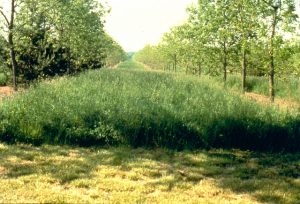Agroforestry systems (integrating crops and livestock) can help reduce input use
 Photo credit: USDA National Agroforestry Center
Photo credit: USDA National Agroforestry Center
Organic farmers must employ integrated management strategies to control pests in an environmentally friendly way. New research finds that these organic strategies can also help large-scale, conventional farmers reduce their dependence on synthetic inputs, by harnessing natural ecosystem functions through ecological intensification. Incorporating “agroforestry systems” by integrating trees and shrubs with other crops or livestock into otherwise monocropped operations is one way to increase biodiversity and ecosystem functions. A study published in the journal Renewable Agriculture and Food Systems interviewed California farmers to determine the benefits of using agroforestry systems. Farmers mentioned increases in soil health, fertility and nutrient cycling, which also improved water retention and reduced soil erosion. Some farmers experienced more disease control, pollination or pest control from the increase in beneficial insects. Economic benefits included risk diversification, lower production costs, and increases in total income. Some challenges were faced as well, such as increased pest and weed problems, and greater labor and equipment needs when farming multiple crops. After considering farm management and economic challenges, the most feasible agroforestry systems to adopt were winter cover-cropping and grazing in established orchards, planting vegetable or row crops in newly planted orchards (aka alley cropping), and planting perennial hedgerows, buffers and windbreaks on field margins. These strategies have been honed in organic systems, but are being adopted by conventional growers because of the benefits they provide.



